Mengcheng Lan
Directed Homophily-Aware Graph Neural Network
May 28, 2025Abstract:Graph Neural Networks (GNNs) have achieved significant success in various learning tasks on graph-structured data. Nevertheless, most GNNs struggle to generalize to heterophilic neighborhoods. Additionally, many GNNs ignore the directional nature of real-world graphs, resulting in suboptimal performance on directed graphs with asymmetric structures. In this work, we propose Directed Homophily-aware Graph Neural Network (DHGNN), a novel framework that addresses these limitations by incorporating homophily-aware and direction-sensitive components. DHGNN employs a resettable gating mechanism to adaptively modulate message contributions based on homophily levels and informativeness, and a structure-aware noise-tolerant fusion module to effectively integrate node representations from the original and reverse directions. Extensive experiments on both homophilic and heterophilic directed graph datasets demonstrate that DHGNN outperforms state-of-the-art methods in node classification and link prediction. In particular, DHGNN improves over the best baseline by up to 15.07% in link prediction. Our analysis further shows that the gating mechanism captures directional homophily gaps and fluctuating homophily across layers, providing deeper insights into message-passing behavior on complex graph structures.
BrainOOD: Out-of-distribution Generalizable Brain Network Analysis
Feb 02, 2025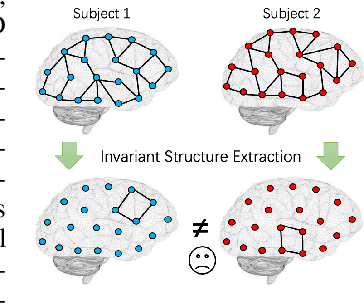


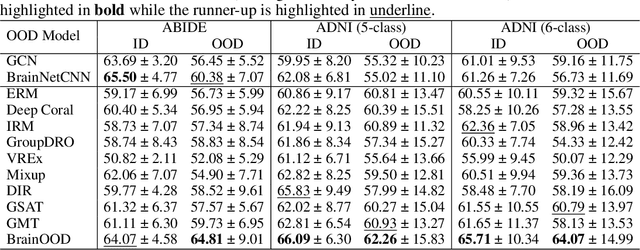
Abstract:In neuroscience, identifying distinct patterns linked to neurological disorders, such as Alzheimer's and Autism, is critical for early diagnosis and effective intervention. Graph Neural Networks (GNNs) have shown promising in analyzing brain networks, but there are two major challenges in using GNNs: (1) distribution shifts in multi-site brain network data, leading to poor Out-of-Distribution (OOD) generalization, and (2) limited interpretability in identifying key brain regions critical to neurological disorders. Existing graph OOD methods, while effective in other domains, struggle with the unique characteristics of brain networks. To bridge these gaps, we introduce BrainOOD, a novel framework tailored for brain networks that enhances GNNs' OOD generalization and interpretability. BrainOOD framework consists of a feature selector and a structure extractor, which incorporates various auxiliary losses including an improved Graph Information Bottleneck (GIB) objective to recover causal subgraphs. By aligning structure selection across brain networks and filtering noisy features, BrainOOD offers reliable interpretations of critical brain regions. Our approach outperforms 16 existing methods and improves generalization to OOD subjects by up to 8.5%. Case studies highlight the scientific validity of the patterns extracted, which aligns with the findings in known neuroscience literature. We also propose the first OOD brain network benchmark, which provides a foundation for future research in this field. Our code is available at https://github.com/AngusMonroe/BrainOOD.
GeoGround: A Unified Large Vision-Language Model. for Remote Sensing Visual Grounding
Nov 16, 2024



Abstract:Remote sensing (RS) visual grounding aims to use natural language expression to locate specific objects (in the form of the bounding box or segmentation mask) in RS images, enhancing human interaction with intelligent RS interpretation systems. Early research in this area was primarily based on horizontal bounding boxes (HBBs), but as more diverse RS datasets have become available, tasks involving oriented bounding boxes (OBBs) and segmentation masks have emerged. In practical applications, different targets require different grounding types: HBB can localize an object's position, OBB provides its orientation, and mask depicts its shape. However, existing specialized methods are typically tailored to a single type of RS visual grounding task and are hard to generalize across tasks. In contrast, large vision-language models (VLMs) exhibit powerful multi-task learning capabilities but struggle to handle dense prediction tasks like segmentation. This paper proposes GeoGround, a novel framework that unifies support for HBB, OBB, and mask RS visual grounding tasks, allowing flexible output selection. Rather than customizing the architecture of VLM, our work aims to elegantly support pixel-level visual grounding output through the Text-Mask technique. We define prompt-assisted and geometry-guided learning to enhance consistency across different signals. To support model training, we present refGeo, a large-scale RS visual instruction-following dataset containing 161k image-text pairs. Experimental results show that GeoGround demonstrates strong performance across four RS visual grounding tasks, matching or surpassing the performance of specialized methods on multiple benchmarks. Code available at https://github.com/zytx121/GeoGround
Text4Seg: Reimagining Image Segmentation as Text Generation
Oct 13, 2024
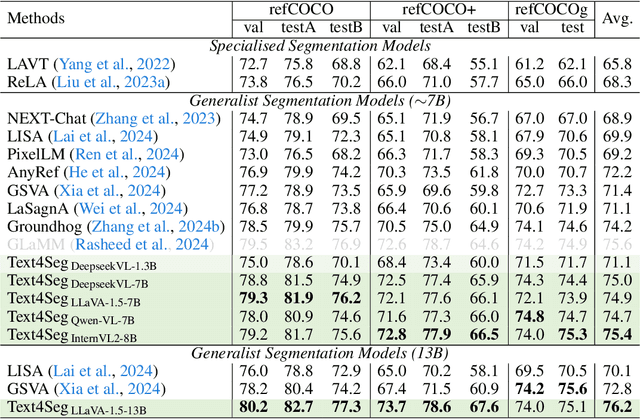
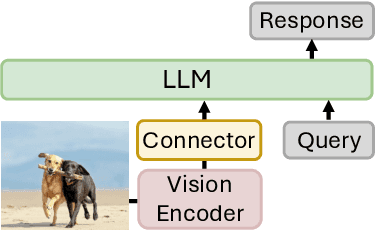
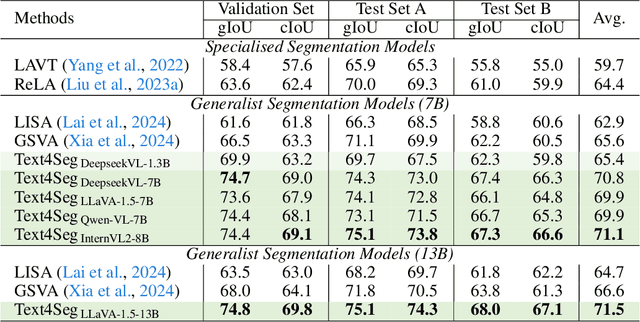
Abstract:Multimodal Large Language Models (MLLMs) have shown exceptional capabilities in vision-language tasks; however, effectively integrating image segmentation into these models remains a significant challenge. In this paper, we introduce Text4Seg, a novel text-as-mask paradigm that casts image segmentation as a text generation problem, eliminating the need for additional decoders and significantly simplifying the segmentation process. Our key innovation is semantic descriptors, a new textual representation of segmentation masks where each image patch is mapped to its corresponding text label. This unified representation allows seamless integration into the auto-regressive training pipeline of MLLMs for easier optimization. We demonstrate that representing an image with $16\times16$ semantic descriptors yields competitive segmentation performance. To enhance efficiency, we introduce the Row-wise Run-Length Encoding (R-RLE), which compresses redundant text sequences, reducing the length of semantic descriptors by 74% and accelerating inference by $3\times$, without compromising performance. Extensive experiments across various vision tasks, such as referring expression segmentation and comprehension, show that Text4Seg achieves state-of-the-art performance on multiple datasets by fine-tuning different MLLM backbones. Our approach provides an efficient, scalable solution for vision-centric tasks within the MLLM framework.
Contrasformer: A Brain Network Contrastive Transformer for Neurodegenerative Condition Identification
Sep 17, 2024Abstract:Understanding neurological disorder is a fundamental problem in neuroscience, which often requires the analysis of brain networks derived from functional magnetic resonance imaging (fMRI) data. Despite the prevalence of Graph Neural Networks (GNNs) and Graph Transformers in various domains, applying them to brain networks faces challenges. Specifically, the datasets are severely impacted by the noises caused by distribution shifts across sub-populations and the neglect of node identities, both obstruct the identification of disease-specific patterns. To tackle these challenges, we propose Contrasformer, a novel contrastive brain network Transformer. It generates a prior-knowledge-enhanced contrast graph to address the distribution shifts across sub-populations by a two-stream attention mechanism. A cross attention with identity embedding highlights the identity of nodes, and three auxiliary losses ensure group consistency. Evaluated on 4 functional brain network datasets over 4 different diseases, Contrasformer outperforms the state-of-the-art methods for brain networks by achieving up to 10.8\% improvement in accuracy, which demonstrates its efficacy in neurological disorder identification. Case studies illustrate its interpretability, especially in the context of neuroscience. This paper provides a solution for analyzing brain networks, offering valuable insights into neurological disorders. Our code is available at \url{https://github.com/AngusMonroe/Contrasformer}.
ProxyCLIP: Proxy Attention Improves CLIP for Open-Vocabulary Segmentation
Aug 09, 2024Abstract:Open-vocabulary semantic segmentation requires models to effectively integrate visual representations with open-vocabulary semantic labels. While Contrastive Language-Image Pre-training (CLIP) models shine in recognizing visual concepts from text, they often struggle with segment coherence due to their limited localization ability. In contrast, Vision Foundation Models (VFMs) excel at acquiring spatially consistent local visual representations, yet they fall short in semantic understanding. This paper introduces ProxyCLIP, an innovative framework designed to harmonize the strengths of both CLIP and VFMs, facilitating enhanced open-vocabulary semantic segmentation. ProxyCLIP leverages the spatial feature correspondence from VFMs as a form of proxy attention to augment CLIP, thereby inheriting the VFMs' robust local consistency and maintaining CLIP's exceptional zero-shot transfer capacity. We propose an adaptive normalization and masking strategy to get the proxy attention from VFMs, allowing for adaptation across different VFMs. Remarkably, as a training-free approach, ProxyCLIP significantly improves the average mean Intersection over Union (mIoU) across eight benchmarks from 40.3 to 44.4, showcasing its exceptional efficacy in bridging the gap between spatial precision and semantic richness for the open-vocabulary segmentation task.
ClearCLIP: Decomposing CLIP Representations for Dense Vision-Language Inference
Jul 17, 2024



Abstract:Despite the success of large-scale pretrained Vision-Language Models (VLMs) especially CLIP in various open-vocabulary tasks, their application to semantic segmentation remains challenging, producing noisy segmentation maps with mis-segmented regions. In this paper, we carefully re-investigate the architecture of CLIP, and identify residual connections as the primary source of noise that degrades segmentation quality. With a comparative analysis of statistical properties in the residual connection and the attention output across different pretrained models, we discover that CLIP's image-text contrastive training paradigm emphasizes global features at the expense of local discriminability, leading to noisy segmentation results. In response, we propose ClearCLIP, a novel approach that decomposes CLIP's representations to enhance open-vocabulary semantic segmentation. We introduce three simple modifications to the final layer: removing the residual connection, implementing the self-self attention, and discarding the feed-forward network. ClearCLIP consistently generates clearer and more accurate segmentation maps and outperforms existing approaches across multiple benchmarks, affirming the significance of our discoveries.
Learning to Discover Knowledge: A Weakly-Supervised Partial Domain Adaptation Approach
Jun 20, 2024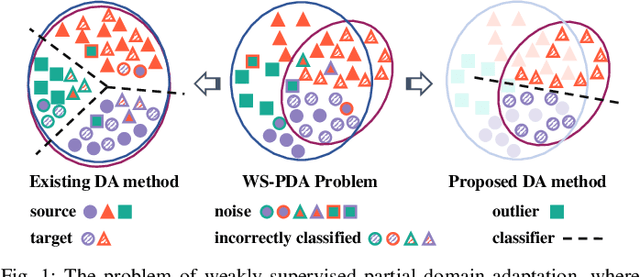



Abstract:Domain adaptation has shown appealing performance by leveraging knowledge from a source domain with rich annotations. However, for a specific target task, it is cumbersome to collect related and high-quality source domains. In real-world scenarios, large-scale datasets corrupted with noisy labels are easy to collect, stimulating a great demand for automatic recognition in a generalized setting, i.e., weakly-supervised partial domain adaptation (WS-PDA), which transfers a classifier from a large source domain with noises in labels to a small unlabeled target domain. As such, the key issues of WS-PDA are: 1) how to sufficiently discover the knowledge from the noisy labeled source domain and the unlabeled target domain, and 2) how to successfully adapt the knowledge across domains. In this paper, we propose a simple yet effective domain adaptation approach, termed as self-paced transfer classifier learning (SP-TCL), to address the above issues, which could be regarded as a well-performing baseline for several generalized domain adaptation tasks. The proposed model is established upon the self-paced learning scheme, seeking a preferable classifier for the target domain. Specifically, SP-TCL learns to discover faithful knowledge via a carefully designed prudent loss function and simultaneously adapts the learned knowledge to the target domain by iteratively excluding source examples from training under the self-paced fashion. Extensive evaluations on several benchmark datasets demonstrate that SP-TCL significantly outperforms state-of-the-art approaches on several generalized domain adaptation tasks.
SmooSeg: Smoothness Prior for Unsupervised Semantic Segmentation
Oct 27, 2023



Abstract:Unsupervised semantic segmentation is a challenging task that segments images into semantic groups without manual annotation. Prior works have primarily focused on leveraging prior knowledge of semantic consistency or priori concepts from self-supervised learning methods, which often overlook the coherence property of image segments. In this paper, we demonstrate that the smoothness prior, asserting that close features in a metric space share the same semantics, can significantly simplify segmentation by casting unsupervised semantic segmentation as an energy minimization problem. Under this paradigm, we propose a novel approach called SmooSeg that harnesses self-supervised learning methods to model the closeness relationships among observations as smoothness signals. To effectively discover coherent semantic segments, we introduce a novel smoothness loss that promotes piecewise smoothness within segments while preserving discontinuities across different segments. Additionally, to further enhance segmentation quality, we design an asymmetric teacher-student style predictor that generates smoothly updated pseudo labels, facilitating an optimal fit between observations and labeling outputs. Thanks to the rich supervision cues of the smoothness prior, our SmooSeg significantly outperforms STEGO in terms of pixel accuracy on three datasets: COCOStuff (+14.9%), Cityscapes (+13.0%), and Potsdam-3 (+5.7%).
MIMO Is All You Need : A Strong Multi-In-Multi-Out Baseline for Video Prediction
Dec 09, 2022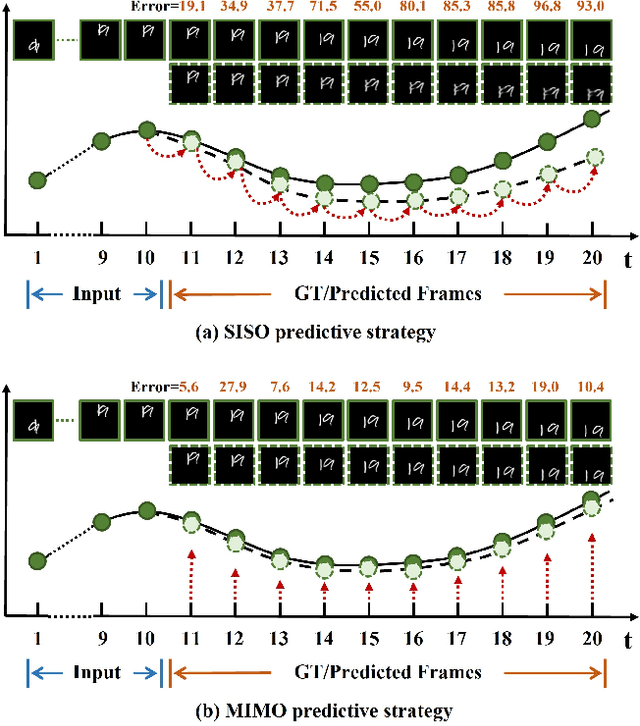

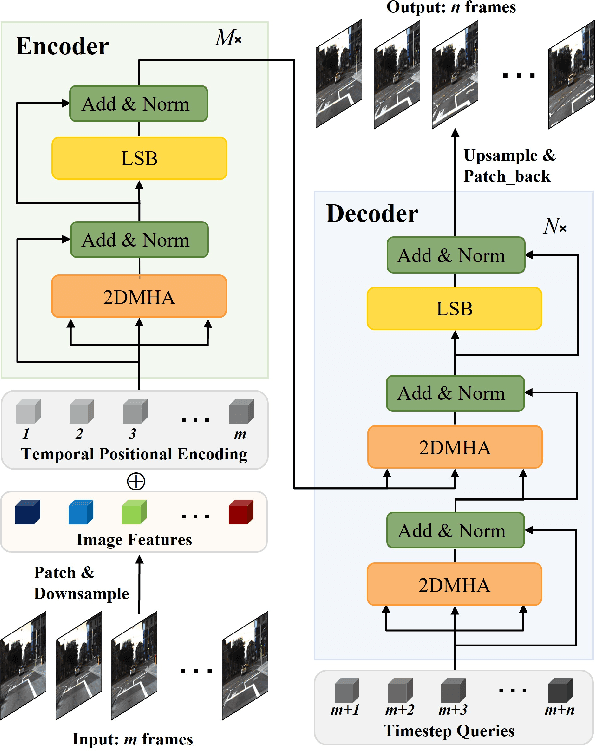

Abstract:The mainstream of the existing approaches for video prediction builds up their models based on a Single-In-Single-Out (SISO) architecture, which takes the current frame as input to predict the next frame in a recursive manner. This way often leads to severe performance degradation when they try to extrapolate a longer period of future, thus limiting the practical use of the prediction model. Alternatively, a Multi-In-Multi-Out (MIMO) architecture that outputs all the future frames at one shot naturally breaks the recursive manner and therefore prevents error accumulation. However, only a few MIMO models for video prediction are proposed and they only achieve inferior performance due to the date. The real strength of the MIMO model in this area is not well noticed and is largely under-explored. Motivated by that, we conduct a comprehensive investigation in this paper to thoroughly exploit how far a simple MIMO architecture can go. Surprisingly, our empirical studies reveal that a simple MIMO model can outperform the state-of-the-art work with a large margin much more than expected, especially in dealing with longterm error accumulation. After exploring a number of ways and designs, we propose a new MIMO architecture based on extending the pure Transformer with local spatio-temporal blocks and a new multi-output decoder, namely MIMO-VP, to establish a new standard in video prediction. We evaluate our model in four highly competitive benchmarks (Moving MNIST, Human3.6M, Weather, KITTI). Extensive experiments show that our model wins 1st place on all the benchmarks with remarkable performance gains and surpasses the best SISO model in all aspects including efficiency, quantity, and quality. We believe our model can serve as a new baseline to facilitate the future research of video prediction tasks. The code will be released.
 Add to Chrome
Add to Chrome Add to Firefox
Add to Firefox Add to Edge
Add to Edge